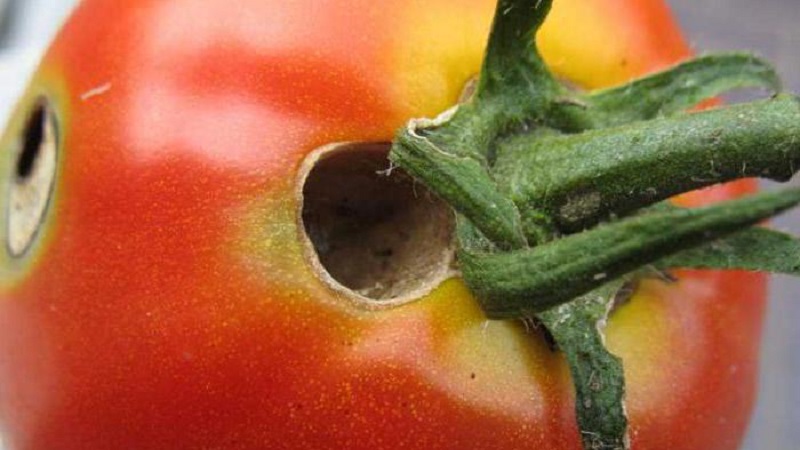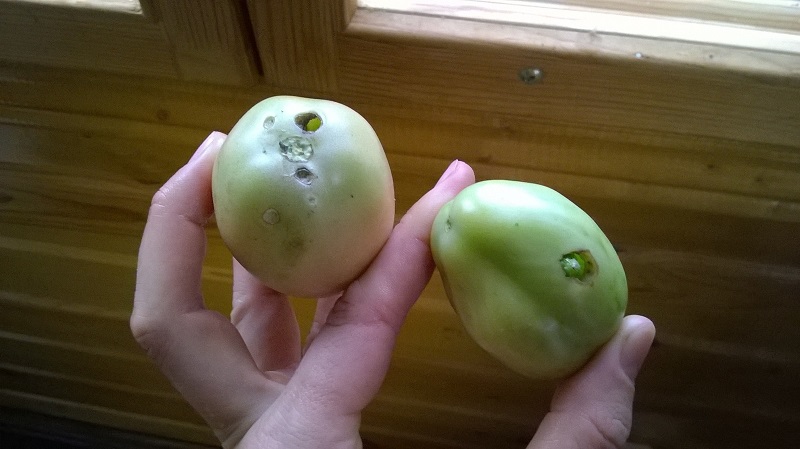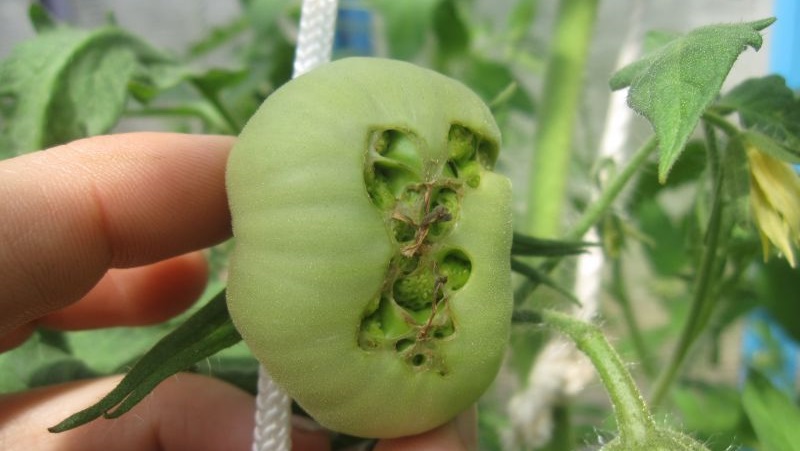We quickly fight the discovered problem of tomatoes: holes appeared in tomatoes - what to do and how to save your crop
The goal of any vegetable grower is to grow a rich harvest. To obtain tasty and large fruits, summer residents observe the crop rotation and the rules of agricultural technology, diligently water, fertilize and weed the beds. However, all work may be in vain due to pests and diseases that affect tomatoes.
In this article, we will figure out what to do if holes have formed in tomatoes: possible causes and the most effective methods of control and prevention.
The content of the article
Why holes can appear in tomatoes
The most common reason for fruit spoilage is the activity of the moth caterpillars. However, tomatoes can also suffer from other pests and diseases.
Caterpillars
The main "eater" of tomatoes is the scoop, or bat. This pest is found in all regions of Russia, both in the open field and in greenhouses. Caterpillars can infect over 120 crops. In one season, 2-4 generations of insects are hatched.
External characteristics of the scoop:
- body length - 1 cm;
- wingspan - up to 3 cm;
- brown color;
- specks on the wings;
- red mustache;
- green eyes.
The insect hibernates in the soil; butterflies emerge from pupae in early June. After 3-4 days, you can see pale yellow eggs on tomatoes. They can be found on the stem, leaves and fruits. At a favorable air temperature, the caterpillars hatch on the third day. Individual development can take 13-22 days. During this time, the caterpillar manages to damage the leaves, flowers and fruits.
The appearance of the scoop caterpillar on tomatoes occurs during the flowering period and the formation of the first fruits. If the beds are not treated, insects will harm the plants until October.
Novice gardeners may wonder if the scoop really spoils their tomatoes. To identify the pest, you can hang a jar of kvass or jam over the beds overnight. If by the morning there are butterflies in the container, you should immediately start the fight. You can also use light and pheromone traps.

Other pests
The miner moth affects tomatoes in the southern regions. The pest gnaws into the stem, stalks and ovary. Caterpillars pupate on plant branches. A new generation of butterflies appears within 14 days.
External characteristics of the moth:
- body length - 9 mm;
- light silver color;
- cream-colored eggs;
- caterpillars are green, with maturation they change color to red, a black stripe appears on the back.
An indirect reason for the appearance of holes in the leaves and fruits of tomatoes is the activity of the whitefly. The insect sucks sap from plants, which provokes the development of diseases.
Diseases of tomatoes
A disease in which black holes appear in tomatoes - late blight... This is a fungal disease, it develops actively in an environment with high humidity. Its main symptom is blackening of foliage and fruits. First, black spots appear, at an advanced stage of the disease, rotting holes form on the tomatoes.

What is dangerous for plants
The caterpillars of the cotton bollworm affect not only leaves and stems, but also fruits. Insects take root in tomatoes, because of which they do not ripen and fall off. Damaged fruits that remain on the plant are unusable.
Large numbers of insects can lead to the loss of the entire crop. During the day, the caterpillars are in the soil, with the onset of evening they begin to crawl out in search of food. During the night, one caterpillar can damage up to 20 tomato leaves and several fruits.
Late blight can also cause the death of the entire crop. The causative agent of the disease takes nutrients from plants and affects the fruits. Its course can be rapid.
Holes in the leaves
Young scoops have a poorly developed gnawing mouth apparatus, so at first only leaves are included in their diet. As the insect grows up, its diet also changes: the fruits of a tomato come under attack.
On green tomatoes
If holes appear on the green tomatoes, it means that a mining moth or scoop is “wielding” on the site. These insects eat both green and red tomatoes equally. As soon as the caterpillar has gnawed the hole, it settles inside the tomato. Affected fruits, regardless of their ripeness, are not suitable for consumption.
Control methods
If you find butterflies, eggs or caterpillars, you need to act immediately. When deciding on the treatment of the beds with drugs, be sure to take into account the degree of fruit ripeness and the number of pests.
And how to treat late blight? You can fight the spread of the disease with the help of chemicals, folk remedies and agricultural techniques.
Chemical treatment
Pest caterpillars can be removed with drugs such as:
- "Decis";
- "Citkor";
- Zeta;
- "Sherpa";
- "Arrivo";
- Inta-Vir;
- "Spark";
- Proteus;
- "Leptocide".
After the first treatment, repeat the procedure after seven days. This must be done because of the extended hatching period of the caterpillars.
Important! When spraying with chemicals, consider the waiting time (the disappearance of the drug from the plant tissue).

Biological preparations
During the ripening and harvesting period, it is necessary to carry out processing with biological preparations:
- "Bitoxibacillin";
- Fitoverm;
- "Lepidocide";
- "Agravertine".
Biological agents help to get rid of only hatched caterpillars. To destroy the pest, it is enough to carry out 2-3 procedures with a break of seven days.
Important!Chemical and biological agents are effective against juveniles. If insects reach sizes more than 5 cm, then no means will take them.
In case of late blight, it is possible to treat the beds with the preparations Fitosporin, Zaslon, Fundazol, Trichopol and Barrier.
Folk remedies
You can fight the scoop and moths with the help of calendula, celery and coriander, which repel insects. These plants are planted around the perimeter of the site.
Helps in pest control and spraying with shooters infusion garlic. Water is poured into a bucket of chopped arrows and the container is placed in a sunny place for seven days. Then the infusion must be filtered and diluted with water in a ratio of 1:10. A small amount of ammonium nitrate can be added to 10 liters of solution. Processing is carried out every 14 days.
For the preparation of the tincture, you can also use the heads of garlic. 200 g of finely chopped garlic is poured into 10 liters of water, the mixture is boiled for an hour, then cooled and filtered. For the best effect, before boiling, you can add 100-200 g of onion husks and 200 g of tobacco dust to it.
Burdock infusion is also used to repel scoops and moths. The leaves of the plant are crushed and put into a bucket so that they take up 1/3 of the container. Then the bucket is filled with water and left for three days. The infusion must be filtered before use; if desired, you can add liquid or grated soap to it. Solution treatment is carried out every 10 days.
Important! Don't throw away spoiled fruits right away. Before disposal, they must be cut and the caterpillar killed.
There are a lot of folk methods against late blight. Most often, spray solutions with iodine, salt, fermented milk products, a mixture of ash and tobacco, garlic and potassium permanganate are used.
Experienced gardeners in the fight against the disease use iodine - an agent with antimicrobial properties. 20 drops of iodine are added to a bucket of water, the solution is used to spray seedlings.

Agrotechnical techniques
Often, pests begin to inhabit the area with weeds. Their eggs can be found on swan, schirin, nightshade, sour and henbane. These plants need to be plucked in May to deprive the caterpillars of their food.
Insects are thermophilic, therefore, by cooling the greenhouse, you can reduce their number. For this, the room is kept open before planting seedlings for 14 days. The air temperature should be no higher than 10 ° С.
Keeping crop rotation helps reduce the risk of pests and diseases. Tomatoes should be planted in a different area every year. You can return to the previous garden bed after 3-4 seasons.
Preventive measures
Prevention of pests and late blight has many points in common. Protecting tomatoes from the formation of holes is very simple: just keep your area clean and tidy.
Pest prevention:
- promptly clean the area of weeds in order to deprive butterflies and caterpillars of food;
- loosen the aisles;
- comply with the terms of chemical processing;
- install grids on the windows and vents of greenhouses;
- monitor the beds during the period of mass flowering and fruit setting;
- at the end of the season, destroy plant residues and dig up the area to a depth of 15 cm;
- twice a year to treat the soil and greenhouses with insecticides.
To prevent late blight, spraying with a serum-based solution can be carried out. Milk bacteria stop the spread of fungal spores, protecting the plant from development illness... The procedure is performed every seven days.

Measures against late blight:
- purchase seeds from trusted manufacturers;
- ventilate regularly greenhouse or a greenhouse;
- carry out pre-planting treatment of beds and seeds;
- with sudden changes in temperature, cover the soil with agrofibre;
- control the level of humidity in the air and soil;
- to water plant under the root, without splashing moisture;
- regularly disinfect soil, garden tools and room structures;
- observe crop rotation.
Tips from experienced summer residents
Vegetable growers often face the problem of hole formation in tomatoes. There are a few tricks you can use in addition to prevention and basic control methods:
- Plants should not be planted close to each other. There should be a distance of 70 cm between the seedlings. The thickened beds interfere with free air circulation, which leads to the development of diseases, and when pests appear, there is a great chance of losing absolutely the entire crop.
- It is necessary to regularly check the leaves - this simple measure will allow you to identify insects and diseases in time. Pay attention to the lower leaves.
- A good measure against pests is the introduction of insecticide granules into the soil.
- It is not necessary to use special preparations in the fight against insects. Moths can be caught with baits, and caterpillars can simply be shaken off the bush.

Conclusion
So that your efforts in growing tomatoes are not wasted, do not neglect preventive measures. If holes begin to form on the tomatoes, take immediate action: determine the cause of leaf or fruit damage and start fighting it.
It is quite difficult to get rid of pests. When deciding to treat the beds with chemicals, first of all, assess the damage done and the number of insects. In most cases, you can drive away the caterpillars using folk methods - they are effective and safer for plants. If the problem of spoilage of tomatoes lies in late blight, immediately start processing them.